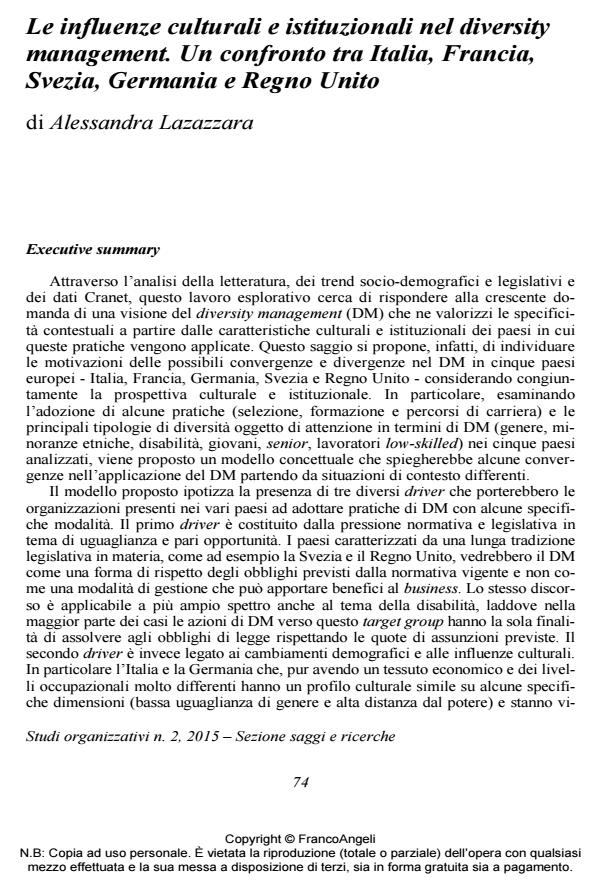Le influenze culturali e istituzionali nel diversity management. Un confronto tra Italia, Francia, Svezia, Germania e Regno Unito
Journal title STUDI ORGANIZZATIVI
Author/s Alessandra Lazazzara
Publishing Year 2016 Issue 2015/2
Language Italian Pages 27 P. 74-100 File size 260 KB
DOI 10.3280/SO2015-002003
DOI is like a bar code for intellectual property: to have more infomation
click here
Below, you can see the article first page
If you want to buy this article in PDF format, you can do it, following the instructions to buy download credits

FrancoAngeli is member of Publishers International Linking Association, Inc (PILA), a not-for-profit association which run the CrossRef service enabling links to and from online scholarly content.
Through a critical review of the scientific literature and the analysis of Cranet data on the adoption of diversity management (DM) practices, this exploratory paper discusses cultural and institutional factors that influence the way in which DM practices are adopted and specific target groups are addressed in five European countries (Italy, France, Sweden, Germany and UK). It emerged that three different drivers lead organizations to adopt DM practices in a specific way according to some contextual peculiarities. The first one is the legislative and regulatory pressure in terms of equality and equal opportunities. The countries showing a long tradition of legislation on equal opportunities interpret DM as a form of legal compliance and not as a management method. The same is also true for disability, where in most cases the DM’s actions towards this target group are exclusively intended to meet law obligations. The second driver is connected to demographic change and cultural influences. In particular, despite having a very divergent economic and employment contexts, Italy and Germany are similar on some specific cultural dimensions (gender egalitarianism and power distance) and are both oriented towards managing gender issues and younger workers at the expense of older workers. The third driver is related to the lack of knowledge and skills in the local labor market that brings companies to attract skilled labor force from abroad and to retrain low-skilled workers.
Keywords: Diversity, diversity management, culture, institutionalism, Europe, Cranet
- Rewind. "Ci vorranno 51 anni in più". Pandemia, assetti organizzativi e lavoro femminile Giulia Maria Cavaletto, in MONDI MIGRANTI 2/2023 pp.39
DOI: 10.3280/MM2023-002003 - Rethinking Work: Pathways and Practices in Business and Society. Introduction to the Special Issue. Luigi Moschera, Mario Pezzillo Iacono, Giovanna Lo Nigro, Laura Lucia Parolin, in STUDI ORGANIZZATIVI 2/2019 pp.9
DOI: 10.3280/SO2018-002001 - The Role of Solidarity in Diversity Management Practices: A Challenge for Social Innovation in Organisations Davide Bizjak, Guglielmo Faldetta, Luigi Maria Sicca, in STUDI ORGANIZZATIVI 2/2019 pp.130
DOI: 10.3280/SO2018-002006
Alessandra Lazazzara, Le influenze culturali e istituzionali nel diversity management. Un confronto tra Italia, Francia, Svezia, Germania e Regno Unito in "STUDI ORGANIZZATIVI " 2/2015, pp 74-100, DOI: 10.3280/SO2015-002003